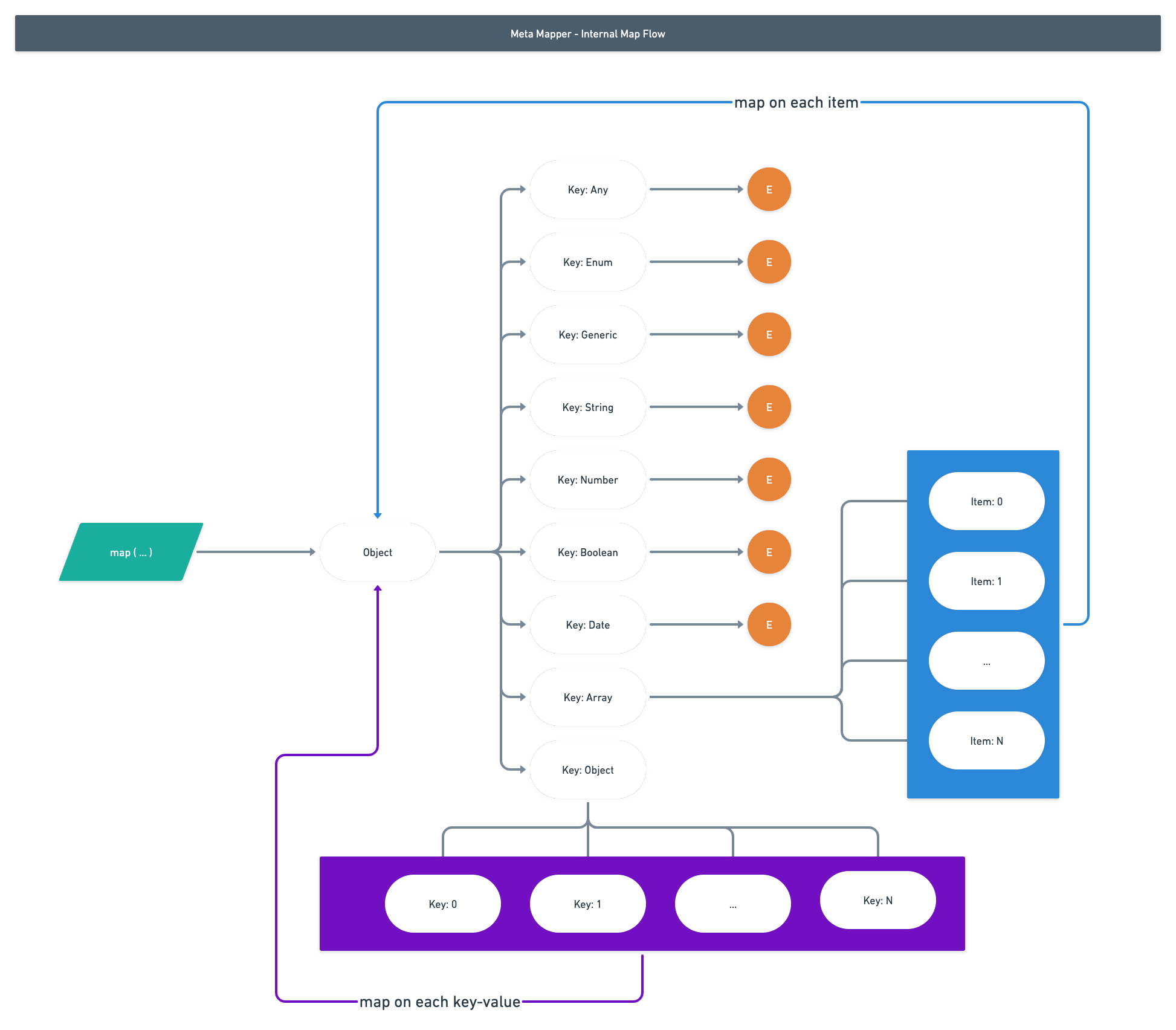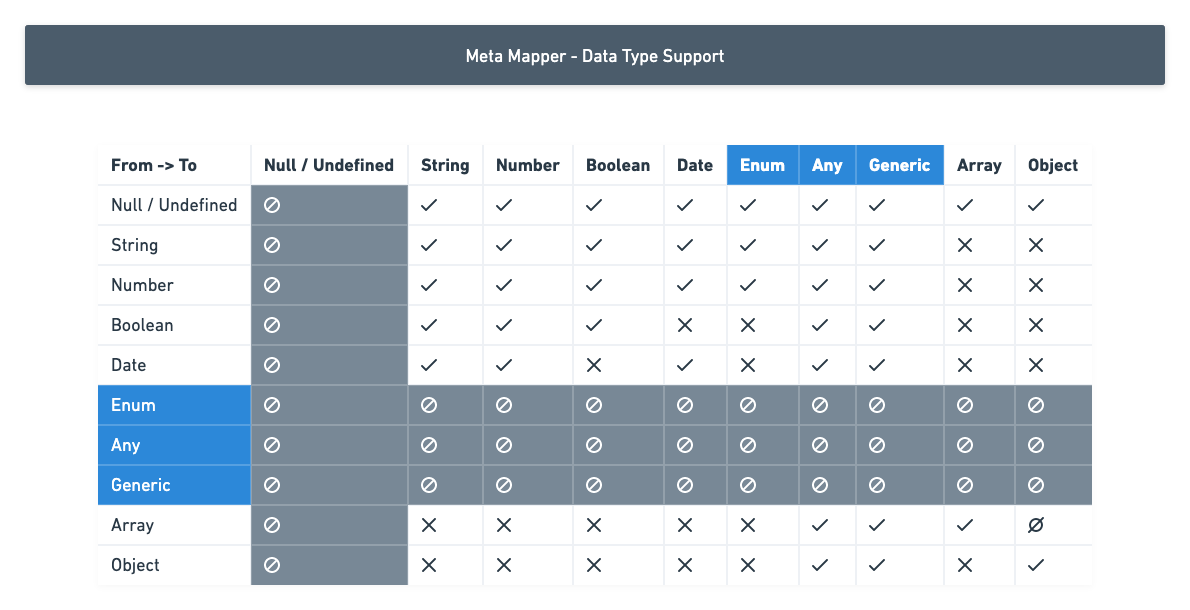meta-mapper
Class based type(object) - mapper(shaper) via meta-data (reflect).
Install
npm install --save meta-mapper
Use scenario
-
Map & sharp the data from request.
Example: data
{ name: "shadow", val: "456", date: "2022-01-01", others: "..." }send from client, we'll need to map & sharp it to{ name: string, val: number, date: Date }. -
Db access need to convert your define class object to db object.
Example: a defined object
{ myName: "shadow" }wanna to map to db object{ my_name: "shadow" }& save in Db, or vice versa.
Feature
- Support basic type
Number|String|Boolean|Object. - Support instance type
Enum|Any|Date|Array. - Support nest structure.
- Support super class.
- Support validation function on property.
- Use stragety
try map as much as possible, theerrorsindicates the runtime mapping issues. - Support generic type w/
Genericclass/keyword since v0.2.0Use a
name(the meta-name) to represent the type wannt, examplepaging.offset.date, for array structure try to use examplepaging.data.$please.
Check more details in test case ingeneric.test.tsplease.
Limitation
- Support class definition instead of object type constraint definition.
- Now support enum int 2 ways, define an
enumor viaarraytype.A.
enum XXXw/@mp("", Enum, () => XXX)
B. array w/@mp("", Enum, () => [......]) - Do not support cycle structure.
If the structure can't use JSON.stringify, then don't use meta-mapper please.
- Do not support custom map function yet.
Exception & Error
- Most of the
Exceptionwas thrown for the definiation error, which means you might correct it on the program phase instead of runtime phase. -
Errorreturned from$rtn.errorswhich represent the map runtime error. It's an array structure since we usetry map as much as possiblestragety.$rtn.errors[$idx].nameis the meta name by default, examplepaging.offset. When there's array structure it could be likepaging.detail.data[2].valueetc.
Performance
Below performance test based on: 2.4 GHz 8-Core Intel Core i9 + 64G Memory.
- A simple class structure - map action would cost 10 ~ 30(us).
- A complex class structure - map action would cost about 100+(us) depends your data structure.
ref: check $/test/performance.test.ts for more details please.
Others
- Null/Undefined is allowed & supported by default as "values" instead of "types".
- Less dependency, only depends on "reflect-metadata"
API
-
@mc(name: string, types: ClassConstructor[])when define a class, attach
@mcon the class as a meta class data.
Example:@mc("my_class", ClassBase)for classclass MyClass extends ClassBase.- name: meta-name (alias) of your class. By default
null|""indicates the same as the class-name. - type: super types of the class.
- name: meta-name (alias) of your class. By default
-
@mp(name: string, types: ClassConstructor[] | Function[])when define a property, attach
@mpon the property as a meta property data.- name: meta-name (alias) of your property. By default
null|""indicates the same as thhe property-name. - types: internal nest types of the property.
-
Any: means should ignore the map action on this property, keep as it is. -
Array: when it's an array, need to define asArray, and the internal element type of theArray.Example:
@mp("custom_array", Array, MyCustomClass)for propertycustom_array: MyCustomClass[]. -
Enum: when it's an enum defined w/enum XXX {...}, need to set asEnumand the real enum object type.Example:
@mp("my_enum", Enum, () => MyEnum)for propertymy_enum: MyEnum.
-
- name: meta-name (alias) of your property. By default
-
@mv_???Validation function. Use mv_custom to define customized validation function please.
-
new(opt: MetaMapperOption)Define your mapper w/ custom mapper options.
- opt: check the option below please.
-
map(type: ClassConstructorGeneric<T>, obj: any, genericTypes?: Array<GenericNameType>): MapperRtn<T>map from any object input to defined class data type.
Example:@mp("my_enum", Enum, () => MyEnum)for propertymy_enum: MyEnum.- type: the class type you wanna to map to.
- obj: the object you wanna to map from.
- genericTypes: If any generic type, indicate it here please. for
Array<T>indicate the name as$(i.e.xx.$.xxx) please.
Mapper Option
| Option | Default Value | Description |
|---|---|---|
| from | PropertyKey |
map from the property-key field, otherwise set as MetaName if from the meta-name please. |
| to | PropertyKey |
map to the property-key field, otherwise set as MetaName if to the meta-name please. |
| validate | true |
global swith: run validation check or not |
| validateUndefined | false |
global swith: when validate, should we validate undefined value or not. |
| validateNull | true |
global swith: when validate, should we validate null value or not. |
| keepArrayLengthMatch | true |
when map failed on an array item, should we still set as "undefined" to keep the array length or not. |
| keepNullVal | false |
if the value is null then keep the key or property conversion. |
| keepOriginVal | false |
no matter whate the value was just keep it the same, note when this flag set the keepNullVal will be ignored. |
Code Example
ref: $/test/readme.test.ts as well pleae.
//1. define your class w/ meta
//@mc short for Meta-Class
//@mp short for Meta-Property
//@mv short for Meta-Validation
@mc
class PagingData {
@mp
code: string;
//meta-alias is "value" instead of "val"
//Note here mark the real data-type of the "val" | "value" as "Number" (instead of the define type "String")
//In later map action, no matter what data-type of the "val" | "value" is, the mapper would try to conver it to "Number" type.
@mp("value", Number)
val: string;
}
@mc
class Paging {
@mp
@mv_number(0, 100, false, "test.paging.offset", "Must between [0 ~ 100]")
offset: number;
@mp
@mv_number(1, 20, false, "test.paging.limit", "Must between [0 ~ 20]")
limit: number;
@mp
date: Date;
//first parameter is "" or null indicates the meta-name is same as the property name, here it's "data" as well.
@mp("", Array, PagingData)
data: PagingData[];
}//2. create a meta-mapper (w/ default option)
//Which a meta-mapper instance can be shared among the application, but if you need different mapper option you might init multiple instance.
//Note by default the opt is from PropertyKey -> PropertyKey
//Here we wanna to test the map from propertyKey to MetaName, so we set "opt.to" to "Meta"
const mapper = new MetaMapper({ to: MetaMapOn.Meta });//3. indicate the class-type to map the object via calling .map() method.
let obj = {
offset: 0,
limit: "20",
date: "2022-01-01 09:10:00+08:00",
value: 100,
data: [{ code: "s-001", val: "001" },
{ code: "s-002", val: "002" }
]
};
let p = mapper.map(Paging, obj);//4. verify the ouput, here the return "p.rtn" would be like:
let pAssert = {
offset: 0,
limit: 20, //convert from String to Number
date: new Date("2022-01-01T01:10:00.000Z"), //convert from String to Date
data: [
//nest data convert from "val" to "value", and type from String to Number
{ code: "s-001", value: 1 },
{ code: "s-002", value: 2 }
]
};
assert.strictEqual(JSON.stringify(p.rtn), JSON.stringify(pAssert));
assert.strictEqual(p.rtn.date instanceof Date, true);

